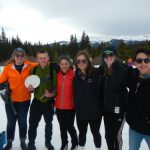HMI Gap bridges many “gaps” in the outdoor community
- Posted by High Mountain Institute
- Categories Gap
- Date March 16, 2017
In recent years, several gaps in the outdoor community have opened up, or just become too visible to ignore any longer. Outdoor advocacy groups have noted the gap between the recreationists who use the land and the conservationists who work to protect it. Seasoned outdoorspeople are well aware of the mentorship gap that has left young adventurers without guidance to gain the requisite skill to continue growing. What may result is a cadre of young outdoor adventurers who tend to view the outdoors as a venue for their own thrill rather than a dynamic system with which they interact.
HMI Gap offers students the opportunity to develop their outdoor skill through a semester spent in the wilderness. In addition to their time honing these skills, students also explore conservation issues and work on projects to protect places on the front lines of the recreation-conservation nexus: the popular alpine of the Colorado Rockies, the desert playground of the greater Canyonlands of southern Utah, and the dramatic mountains of Patagonia, including the future Patagonia National Park, recently in the news for its inclusion in a large-scale land donation to the Chilean government.
Our courses really focus on the intersection of adventure, conservation, and leadership. Students get to explore these amazing recreation resources and actually get their hands dirty to protect them. And whether students are meeting with a forest ranger to conduct an impact survey or working together to cross an alpine ridge in a snowstorm, they’re learning leadership skills that will serve them no matter what they do in life.For example, in the fall of 2015 Gap students did a trail project on the iconic Castleton Tower, several miles north of Moab, UT in partnership with the Front Range Climbing Stewards (FRCS), a professional crew that specializes in building climbing access trails.
Castleton, considered one of the “50 Classic Climbs of North America,” sees hundreds of visitors each year who aspire to reach its summit. The tower itself is a challenging 300 feet of climbing, but just arriving to the base involves a steep hike up 1500 feet of unstable talus. The trail through the talus is hard to follow and has suffered from both natural and human-caused damage, which has increased erosion and in turn further degraded the delicate desert ecosystem.
During the 2-week project, the FRCS mentored Gap students to build elaborate stone stairs, retaining walls, and drainage systems – all out of natural materials found in the area – to create a more sustainable and durable trail that climbers use to access the tower. As one Gap student described the project, “We are learning lots of cool rock moving and splitting techniques and getting to be part of a major effort to care for one of the more iconic climbing objectives in the world.”
Alongside their service work, students learned and practiced advanced climbing skills. After finishing their work, the students hiked up the trail they had rebuilt and put these skills to use to successfully scale Castleton Tower.
As much as HMI Gap aspires to address the gaps in the outdoor community, it’s most basically about offering a profound experience to each of its students. Anyone who has spent much time in wild places knows the powerful learning that happens, both in terms of the skills and experiences, to be in these wild places and concepts that inform how we live “out of nature.” For example, we acquire the skills to climb a remote alpine wall and cultivate the vision and fortitude to attempt such audacious goals. This is the kind of learning HMI Gap offers: the support to empower students from all walks of life the chance to explore the outdoors, the mentorship to help them gain the skills to do so responsibly, and the perspective to help them pursue these adventures with a sense of stewardship for the land where they travel.


 Semester 38: “A fantastic week at HMI”
Semester 38: “A fantastic week at HMI”
 Semester 38: Second Expedition
Semester 38: Second Expedition